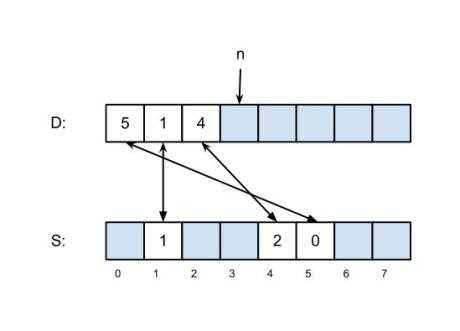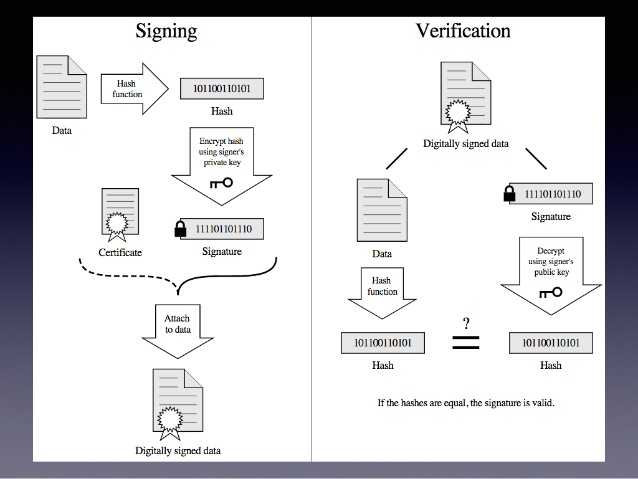标签:use ogr discus oda union 数组 cci 数据结构 number
<Programming Pearls> solutions for Column 1中的第9题题解
关键字: Sparse set
原题:
The effect of initializing the vector data[0..n-1] can be accomplised with a signature contained in two additional n-element vectors, from and to ,and an integer top.
If the element data[i] has been initialized, then from[i] < top and to[from[i]] = i.
Thus from is a simple signature, and to and top together make sure that from is not accidentally signed by the random contents of memory.
Blank entries of data are uninitialized in this picture :
data: 请想象这里有一幅图,其中有三个数组
from:
to:
The variable top is initially zero; the array element i is first accessed by the code
from[i] = top
to[top] = i
data[i] = 0
top++
=============================================Hua Li De Fen Ge Xian =====================================================
对这个问题的解释请参考: Sparse Sets
引入了一个新的数据结构
We look today at a clever data structure for storing sparse sets of integers on the range 0 .. u?1 and performing initialization, lookup, and insertion is time O(1) and iteration in O(n), where n is the number of elements in the set. The data structure was studied in a 1993 article “An Efficient Representation for Sparse Sets” by Preston Briggs and Linda Torczon, in Exercise 1.9 (1.8 in the first edition) of Jon Bentley’s book Programming Pearls, and in exercise 2.12 of the 1974 book The Design and Analysis of Computer Algorithms by Al Aho, John Hopcroft and Jeffrey Ullman; the data structure itself dates to the folklore of computing.
The data structure considers a universe of integers from 0 to u?1; depending on the circumstances, the integers probably map to something else, but we don’t care about that. Any given set consists of n items chose from the universe; there are no duplicates. Note that n ≤ u, certainly, and likely n is much less than u — otherwise, you would probably use a bit vector to represent the set. Note also that we are optimizing for speed at the expense of space, as a bit vector takes u bits but our data structure takes 2u integers.
Think about a bit vector. Setting a bit is a constant-time operation, as is checking if a bit is set or unset. But initializing the bit vector and iterating over the set elements of the bit vector each take time proportional to the size of the bit vector. Our sparse sets reduce the iteration to time proportional to the size of the set (rather than the size of the universe) and reduce the initialization time to a constant.
The sparse set is represented by two vectors that we will call dense (abbreviated D) and sparse (abbreviated S). Initially n, the number of elements in the set, is zero; the two vectors are uninitialized and may contain anything. To add an element 0 ≤ k < u to a set that does not already contain k, we set D[n] to k, S[k] to n, and increase n by 1, an operation that takes constant time. After this, the two vectors point to each other, which gives a test of set membership that also works in constant time: an element k is in the set if and only if S[k] < n and D[S[k]] == k>. Note that if k is not a member of the set, the value of S[k] doesn’t matter; either it S[k] will be greater than n or it will point to an element of D that doesn’t point back to it. The diagram above right shows a set with the elements 5, 1 and 4; the blue boxes may contain any value. To iterate over the elements of the set, read D[0 .. n?1], which takes time O(n), and to clear the set make n = 0, which takes time O(1); note in particular that clearing the set doesn’t require reinitialization. Other operations, including size-of, delete, union, intersection, difference, and set-equality are possible, and equally time-efficient compared to bit vectors, but we won’t discuss them here, since they are seldom used with this representation of sets. A common use of these sparse sets is with register allocation algorithms in compilers, which have a fixed universe (the number of registers in the machine) and are updated and cleared frequently during a single processing run.
 (可以看出D和S的关系: 对某个D[i], 有S[D[i]] = i , D的下标为S的值, S的下标为D的值, 倒过来也成立)
(可以看出D和S的关系: 对某个D[i], 有S[D[i]] = i , D的下标为S的值, S的下标为D的值, 倒过来也成立)
===========================================================原题的解释=========================================================
说人话(可能是):
from 和 to 一起作为一个数据结构, 表示一个稀疏集.
特点: key indexing 和一个 wily signature scheme
这个数据结构的优点是:
不需要初始化from和to数组, 即使没初始化的元素是内存中的随机值也没关系
根据from[i] < n && to[from[i]] == i, 来判断 元素i 是否在集合中.
各个操作时间复杂度:
O(n) : 遍历集合
O(1) : 清除clear集合
如何理解原谅所说的signature?
这里的signature应该是指数字签名 (digital signature)的签名

说成signature可能是想表达: 上图中, signature既可以由原始数据的Hash值加密生成, 也可以由signature解密生成Hash.
类比: 若某个元素n在集合中, 由from[n] 得出元素n在to[ ]数组中的下标. .....
好吧,我解释不上来........
标签:use ogr discus oda union 数组 cci 数据结构 number
原文地址:http://www.cnblogs.com/longwaytogo/p/6362964.html